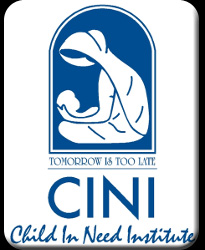 |
||
29th November 2009
Royal Festival Hall |
||
| Home | DVD | History | Charities | Sponsors | Contact Us |

Child In Need InstituteThe Child In Need Institute (CINI) helps poor mothers and children in India. It works at the grassroots with local community groups and government bodies to bring about sustainable improvements in nutrition, health, education and protection. Programmes are implemented by local staff and volunteers, making full use of skills available locally and keeping costs low. CINI shares successful approaches it has developed with other organisations. It is widely recognised as a leading authority on mother and child nutrition and healthcare in India, and has provided training on related issues to staff from major charities such as UNICEF, CARE and CRY, as well as many smaller local NGOs. |

|
The Indian government has recognised CINIís outstanding work by giving the charity the National Award of Child Welfare twice, once in 1986 and again in 2005. It is the only NGO known to have won this award more than once. Recipients of this award are chosen on the basis of the quality of their programmes, their significance in leading the way on improving child welfare in India, and the numbers of children whose lives have been touched by the charityís work.
In November 2007, Dr Chaudhuri, the founder and Director of CINI India, was awarded the World of Childrenís Award for his dedication to work to improve the lives of hundreds of thousands of poor children.
CINI UK has a close working relationship with CINI in India, but has an independent set of Trustees. We are rigorous in requiring narrative and financial progress reports, the format of which have been devised in consultation with CINI India staff so that they are useful for programme management and not excessively burdensome.
We carefully monitor these reports and work with CINI on any of areas of concern, to help support learning from experience and the continual improvement of programmes. We are dedicated to maximising the effectiveness of CINIís projects, and to ensuring the long-term financial sustainability of CINIís work.
The Evelina Children's Hospital |

|
The Evelina Children's Hospital at Guy's and St Thomas' moved to a stunning new purpose built hospital at St Thomas' in 2005. With everything from the menus and furnishings to the design of the building itself chosen by children, it's something truly special.
It is also London's first new children's hospital for more than 100 years.
The Evelina Children's Hospital includes:
- 140 inpatient beds, including 20 intensive care beds
- Three operating theatres
- Full children's imaging service - includes MRI scanner, general x-ray and ultrasound
- Kidney dialysis unit
- Outpatients department
- Medical day care unit
- Hospital school

The Anthony Nolan Trust
In one sense, all we do is connect people.
We connect one person, whose immune system needs a boost Ė with another person, who is prepared to share a little of theirs. Matching patients with donors.
Of course, the detail is more complicated.
In the case of leukaemia, intensive chemotherapy and radiotherapy are used to eradicate the disease. The intensity of these treatments, known as conditioning, has the negative effect of severely weakening the patientís immune system. The transplant provides the patientís body with healthy cells capable of regenerating the immune system.
A critical factor in the success of a transplant is the accuracy of the match between the patientís cell tissue and the donorís. Timing is also critical: once a patient has chosen to proceed with a transplant, the donorís tissue Ė in the form of bone marrow or peripheral blood stem cells Ė must be available as soon as the conditioning treatment has finished.
If we take this as a rough guide to what we are trying to achieve, it is simple to explain what we do as an organisation.

